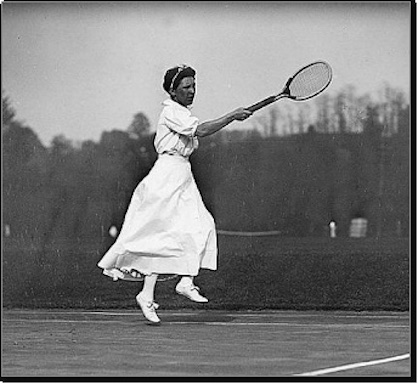
Sport: Tennis
Born: March 5, 1876
Died: January 22, 1959
Town: Ridgewood, New Jersey
Elisabeth Holmes Moore was born March 5, 1876 in Brooklyn and grew up in Ridgewood, New Jersey. Her father, George, was a wealthy cotton trader. Her mother, Sarah—herself a mere teenager when Bessie was born—encouraged her to be an active child. She rode her pony on local trails and, around the age of 12, took up the sport of lawn tennis at the Hohokus Valley Tennis Club, where her father was president.
Bessie was a natural. She entered and won several ladies tournaments in the early 1890s and, at the age of 16, entered the U.S. Championships in Philadelphia. She surprised spectators by reaching the finals, where she faced the defending champion, 39-year-old Mabel Cahill. In the first 5-set match in an American tournament, Bessie fell in the final set. Between the fourth and fifth sets, Cahill disappeared into the clubhouse to cool off, while the younger Bessie waited in the sun for her to return. This proved to be the difference, as Cahill overwhelmed her, 6–2. Not until Pam Shriver reached the finals in 1978 did a younger woman make it to the championship round.
Bessie reached the semifinals of the 1893 tournament, skipped the 1894 competition for health reasons, and reached the finals again in 1895 against Juliette Atkinson. In 1896, the two faced off again with the women’s title on the line. This time Bessie won, 3 sets to 1. A day earlier, they had teamed up to take the doubles title. In 1897, Atkinson defeated Bessie in the final to reclaim her title. Over the next decade, Bessie would rank among the nation’s top doubles and mixed doubles players.
However, it was as a singles player that Bessie became a crowd favorite. She was great fun to watch. Though not particularly quick or graceful, she has excellent anticipation and returned the ball with great accuracy and consistency. Unlike most women of her era, Bessie’s backhand was as good as her forehand. This enabled her to win long rallies. Her precise shot-making made quick work of opponents who rushed the net. Occasionally, when a ball was unreachable on her backhand, she would switch the racquet to her left hand to make the return.
In 1898, Bessie traveled overseas to compete in the Irish Championships in Dublin. Both of her parents were of Irish descent. Though she failed to win the tournament, she holds the distinction of being the first American woman to play in a major overseas tournament.
Ill health kept Bessie off the court until 1901, when she made a rousing comeback. She defeated Atkinson and won a five-set final against sitting champion Myrtle McAteer. In 1902, Bessie faced Marion Jones in the final, but had to retire after fainting early in the second set. Ironically, 1902 marked the year that women’s matches were change from best-of-five to best-of-three. Bessie was among the most vocal players lobbying against the change. Ever resilient, she won her third U.S. crown in 1903 and her fourth and final one in 1905.
Although Bessie no longer competed in the US outdoor championships, she continued to play other tournaments in America and abroad. She won the first US Indoor singles championship in 1907 and the indoor doubles in 1908. Bessie’s breathing difficulties worsened after she turned 30, but she still was a dangerous doubles player. She was still winning tournaments in her early 40s.
Bessie split her time between New York and Florida after her playing days. She lived to the age 82 and passed away after a long battle with emphysema. She was enshrined in the Tennis Hall of Fame in 1971.